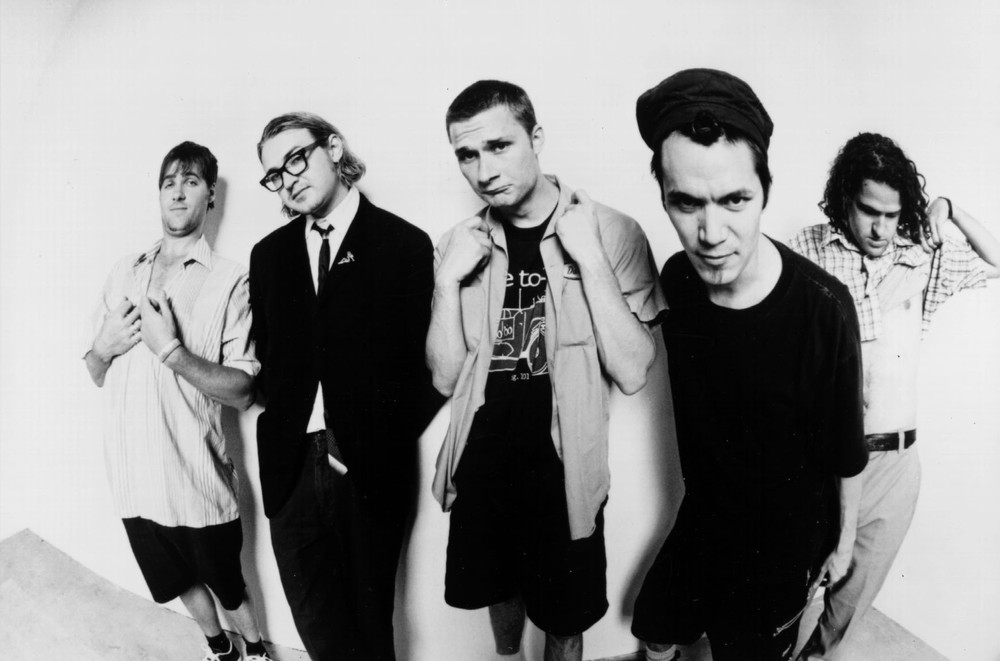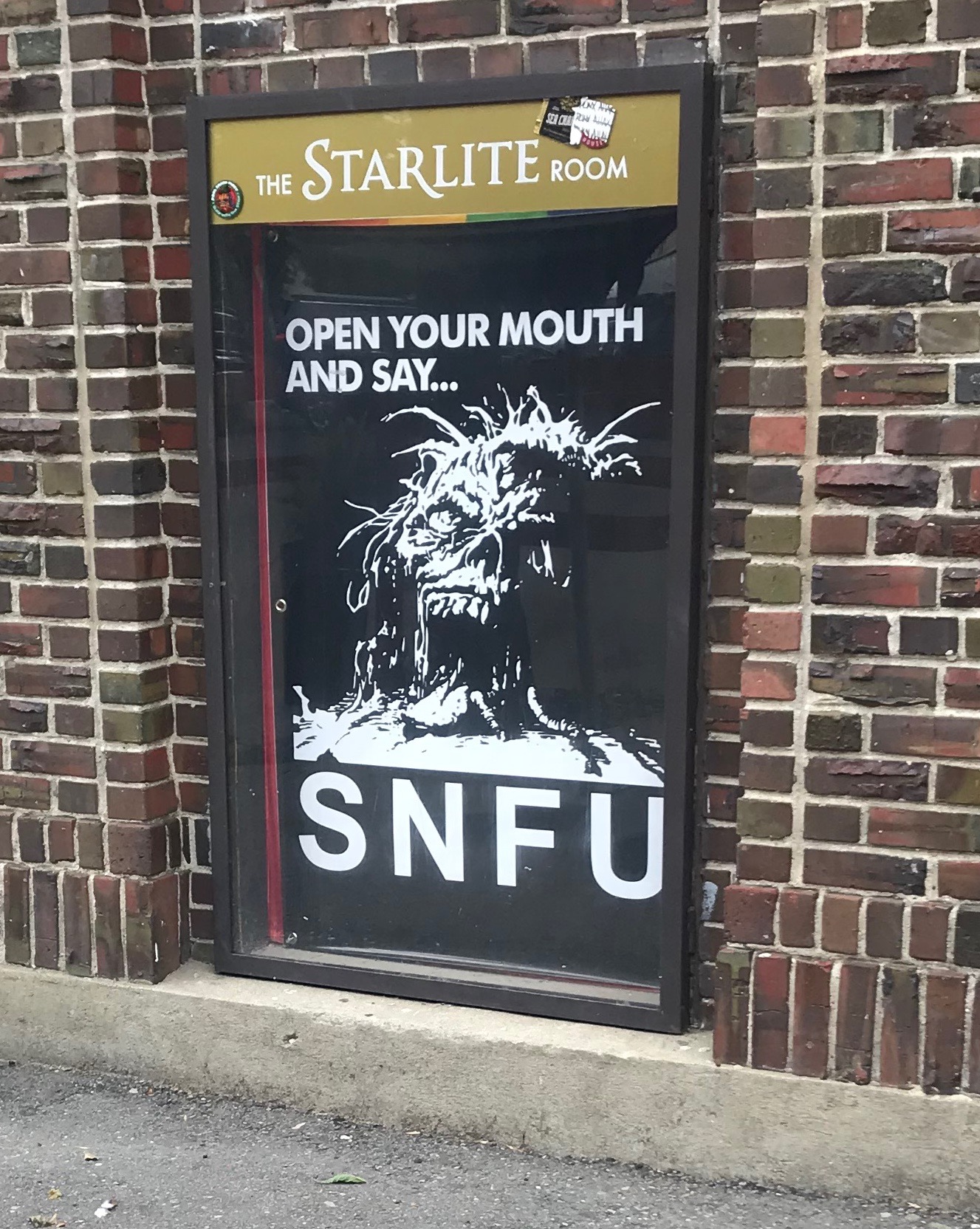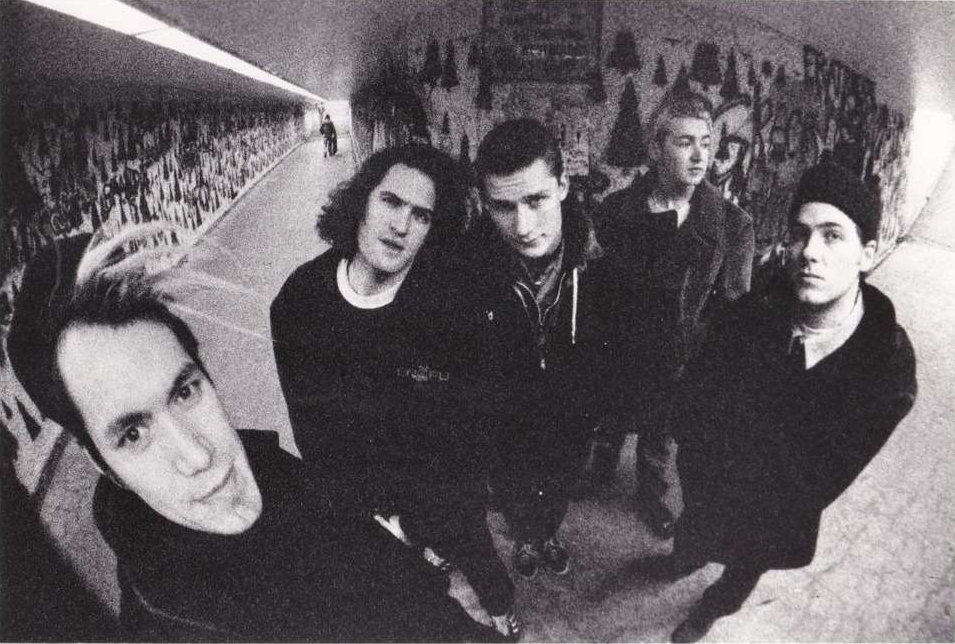
This chapter of SNFU’s early years, taken from an unpublished book project that was undertaken by Steven Sandor two decades ago, looks at the childhood of Ken Chinn, who would go on to be known by punk-music fans as Chi Pig. Chinn passed away over the summer, and we hope this series serves as a remembrance of a true Edmonton original. Part 1 Part 2 Part 3
It’s the summer of 1994, and a California punk trio named Green Day are in Edmonton for the first time. Before they take the stage at the University of Alberta’s Dinwoodie Lounge, they make a pilgrimage, of sorts.
Drummer Tre Cool takes LSD and visits the West Edmonton Mall. Why? Well, there’s a heavy influence from lyrics written by Chi Pig.
“He’s just fascinated with that mall,” Green Day lead man Billie Joe Armstrong told me back in 1995. “It’s just like that SNFU song, ‘Thee Maul That Heats Peephole.’”
On the west side of our town there’s a mall that always grows
It feeds on tourists and late-night shoppers
That song, from SNFU’s third album, Better Than a Stick in the Eye, was released in 1988 — and, it made a massive impression on the guys who would form Green Day. It shows how, in the most subversive of ways, Ken Chinn’s lyrics spread far beyond Alberta’s borders.
Chi Pig was a persona created by a man who spent his childhood trying to stand out from the crowd — even in his own family. The second-youngest in a family that included five brothers and six sisters, young Kenny Chinn always struggled not to get lost in the shuffle.
“When you live in a big household like that, to get the attention of your mother and father, you have to compete against 11 other people,” remembered Chi. “You have to find a way to stand out — you have to know exactly what it will take to get attention.”
Chi’s father, Donald Chinn, was regularly in trouble with the law. The Chinns’ family home, located in the Fort Road area of northeast Edmonton, was a compound. Even in the ‘70s, the Chinns did not have plumbing — Chi said that the family did their duties in a neighbouring outhouse. Chi recalled that water had to be boiled before it could be used for bathing.

Donald was a welder by trade, who also ran bawdy houses; he had a workshop located on the property, near the home. The kids were told never to go inside; mainly because the workshop was a hiding place for stolen goods their father was trying to fence. But Donald was also a packrat; he loved to build toys for the kids out of scrap metal. He built them a hand-cranked ferris wheel, a bizarre contraption that had to be dismantled after it nearly took the head off of a neighbour’s little girl. There was also a merry go round and swing set made out of iron piping.
In the middle of the yard stretched a clothesline, near the derelict cars that served as forts for the playing children. Chi remembered that one of his older brothers strung him from that line and set the family German Shepherd, Duffy, at young Kenny’s feet.
Edna Braun — Kenny’s mom — struggled with the bottle, but she fostered a love of music through her family. Even though they were ragged group of misfits, they all enjoyed listening to the radio and emulating the pop stars of the time. Kenny loved the ‘70s bands that wore make-up on stage; Alice Cooper, Kiss and Peter Gabriel during those early Genesis art-rock years.
Donald was 43 when Kenny was born; Edna was 12 years his junior. When their father was away, the family spent a short time in Winnipeg, but soon came back to Edmonton.
Kenny was a problem child — a kleptomaniac who loved to compete with his six brothers and five sisters for his parents’ attention. If Kenny wasn’t stealing stuff or listening to music, he was skateboarding. And he was damn good at it, too. But school repelled him.
“I had to repeat Grade 8 because I had missed three months of school,” said Chi. “I didn’t like school, especially in the summer. I would rather be skateboarding or stealing.”
Instead of obsessing over homework, Kenny kept up with his favourite bands through Circus magazine, which he stole regularly from Arden’s, a grocery store which was located on his bike route (Kenny used to be a delivery boy for Mel’s Pharmacy). And he loved to keep up with the antics of dress-up favourites, like Alice Cooper and Elton John. Yes, he would become a punk rocker; but as a lad, the idea of rock as theatre was what fascinated Kenny. That carried over to the band; there were early SNFU shows where Chi Pig placed black grease around his eyes to make them look like they’ve been blackened; the odd punk who believes that music history begins with the Sex Pistols might mistakenly think that Chi took influence from the Misfits or the Damned. In fact, it went back to Alice Cooper.

Vincent Furnier, the man who would become known to the world as Alice Cooper, is fully aware of this — and he’s not shy about bragging about his influence on what later became known as punk.
“It amazed me when a band like the Sex Pistols said that one of their biggest influences was Alice Cooper,” he once told me in an interview. “But I found that i was a big influence on a lot of punk bands — they took my music and just digested it differently.”
In a family of 14 people, it’s difficult to get everyone together in one room at one time; in the Chinn household, the unifying force was Don Kirshner’s Rock Concert, the TV show that brought glam rock to the small screen. Young Kenny and his brothers and sisters loved to watch the biggest stars of the ‘70s play. So what if the performances were contrived? Because he was too young to go to concerts, this was Kenny’s education in rock ‘n’ roll theatre.
Ken said that he would actually take the time to listen to prog-rock from the likes of Wishbone Ash and Savoy Brown that wafted from the speakers when his brothers commandeered the turntable. But he would still faithfully go down to Kelly’s Music and dutifully steal a few more records for his collections week after week. Ken’s collection of Top-40 45s was growing steadily.
In fact Rich Liukko, leader of Edmonton ska act Mad Bomber Society and proprietor of Freecloud Records, once stumbled upon a used 45” of Neil Sedaka’s “Bad Blood.” On closer inspection, he noticed that the words “Kenny Chinn” were scrawled on the label. Liukko had stumbled on a piece of Chi’s childhood.
How did that record leave Kenny’s possession? it may have occurred when the cops decided to raid the Chinn place. The family got word of the raid just in time to hide 100 of Kenny’s records; but the cops got the rest. Probation and community service was the penalty he received for all the five-finger discounts he received at Kelly’s Music.
Or, Liukko could have been the beneficiary of the deviousness of Chi’s older brother.
“One day I came home and I found that my whole record collection was gone,” remembered Chi. One of his older brothers had pawned a bunch of stuff.
“I wasn’t so pissed that he stole them off me,” he said. “It was more like karma. I had stolen, so I had to find out what it was like to be stolen from.”
After repeating Grade 8, he enrolled at Victoria Composite High School, a place that would foster his love of drawing. When he got to high school, his personality changed, though. He was no longer outgoing; he was an introvert, who didn’t try to fit in with the in crowd. His only outlet was his skateboard. Ken and his youngest brother, Danny, joined a skateboard team sponsored by Skier’s Sport Shop — and they were damn good.
But they had rivals. Del’s Skating Team was damn good, too—led by twin brothers Marc and Brent Belke. While the competitions were intense, there was no real animosity between the teams. Chi and the Belkes soon became friends; little did they know that they would become bandmates.
Chi admits that he was “a teenage klepto.” Stealing wasn’t so much a compulsion as it was force of habit. He continued to steal records, but instead of keeping them, he found it was more profitable to sell them to local kids. Afterwards, he’d taken the cash and buy the latest in experimental music he could find; by now, the prog-rock efforts of his older brothers had paid off. Ken eschewed Top 40 stuff for more serious stuff. No one as ever sure what he’d buy when he got to the record store; it might be art-rock á lá Focus, or modern jazz from Herbie Hancock. In Ken’s mind, it was all good.
And then punk broke, and Ken’s mind was sent into a spin.Unlike every other member of his family, who detested the spikes, torn clothes and dyed hair, Ken was immediately absorbed by the Sex Pistols. After one play (right after he stole it), Never Mind the Bollocks became Ken’s favourite album of all time.
“I loved that they had fake names like Sid Vicious and Johnny Rotten,” said Ken. “It was so totally raw and English and angry — all at the same time. And I thought ‘Bodies’ was cool because Johnny Rotten said ‘f—’ four times in a row.” (For any of the readers under 40: Before hip-hop, F-bombs in songs used to be a really big deal.)
It was an epiphany for Ken — by the time he hit Grade 11, he had driven away the few non-skateboarding friends he had with his dyed hair and punk-rock attitude. While everyone else in Edmonton was grooving to disco or rocking out (“rocking out” being a term used very loosely in this instance) to the likes of Boston and Foreigner, Chi was discovering a new world.
Never Mind the Bollocks irked one of his brothers so much, that he stole it and pawned it. But this time, Chi showed resolve. He promptly went out and stole another one.
By 1979, the skateboard mags had all turned on to punk and New Wave. By this time Ken had begun seeing punk rock shows — he remembers a ‘79 Subhumans show with great reverence. He became a fan of the young American punk scene, and was completely blown away by the Talking Heads’ “Psycho Killer.”
By then, Edna had remarried. To say that Ken’s mom and her new husband were a liberally-minded couple would be an understatement. They would often get Ken to pick them up an R-rated mag or two on his way to school. He was actually caught red-handed at Vic Comp with an issue. One can imagine the teacher’s surprise when Ken told her not to bother calling his parents; the mags weren’t his —they belonged to his mom — and she knew he had them, anyway.
This is as good as any to discuss Ken’s sexuality. You’re right to wonder why it’s taken this long to address it. Ken was gay. He was open about it. But, in the time I spent talking to him, he never really equated it to why he wanted to be a punk. In fact, he didn’t really seriously address it at all.
He definitely had a dislike of all things macho — he spoke about how he was never impressed when the Oilers would show up at the pizza place he worked at later in the 1980s. It came out in songs like “She’s Not on the Menu,” where he called out the culture of misogyny.
But, when I spoke to Ken directly about how tough it was to be a gay, Asian singer in a white-dominated musical genre, he would often hide behind humour. It was a subject that, in interviews, he would deflect by making jokes about what he found attractive in men.
Chi waited till the band’s 1988-89 tour, after the band had put out its third album, Better Than a Stick in the Eye, to come out to his bandmates. That tour included an oversold night at Vancouver’s Commodore Ballroom, on a bill with an up-and-coming band from Los Angeles called… the Red Hot Chili Peppers. And it was on this tour, during a trip in the van, that Chi dropped a bomb on his bandmates.
“What happened is that he put his hand on my knee and asked me ‘How does that make you feel?’” recalled Marc.
Ken left Vic Comp in ‘81 — by then he had left Edmonton’s west end for Mill Woods, where one of his sisters lived.
That’s when it happened; Chi asserted himself as a true punk rocker by getting his first Mohawk. He remembered getting it done while listening to Fear on The Decline of the Western Civilization soundtrack on the stereo.
Chi remembers the silence that hung over the dinner table at his sister’s place that night.
“You could feel the tension at the table,” he remembers. “Finally, she said it: ‘Why did you have to get your haircut like that?’ And I yelled back: ‘Because I f—–g wanted to!’ You have to remember that this was Edmonton in 1981, and people just weren’t used to seeing people with hair like that.”
During those years, Ken has managed to hold down a job at Saveco. He said he was finally fired for showing up to work with hair that was dyed blue and black, with bright yellow spikes.
But Chi denies that he was a bad employee. In fact, he claims that he was downright friendly.
“I remember when people would go to the manager and he’d tell them, ‘You’ll need to speak to Ken’ and they were surprised when I was nice to them. In fact, we had a blind, old Chinese man who shopped at the store once a week—and he’d always ask for Ken to help him with his shopping.”
That was the thing about Ken. Anyone who spent time with him saw that under the mental illness and addictions that would plague him through his life, there was a caring, empathetic human being. And it might not be such a bad way to remember him, not just as a fiery lead singer of one of Canada’s most-loved punk acts, but as a well-intentioned kid helping a blind senior do his weekly shopping.
SNFU broke up for the first time in 1989; this series is meant to focus on the band’s early Edmonton years, but in fact the SNFU name continued right up to Chi’s death in 2020. The band broke up, got back together, relocated to Vancouver and broke up and reformed many more times over the years.
The band’s Discogs biography lists 20 people who have recorded with the band over the course of 11 albums and singles, from 1985-2019. In the ‘80s SNFU was a band, the vanguard of Edmonton’s music scene at the time. It became more of a collective, a revolving door of musicians, after Chi moved to Vancouver. Marc Belke would outlast his brother, Brent, in the band — but even he spent many of SNFU’s later years outside of the group.
Chi was SNFU’s only constant — for him, there was no other outlet, no day job waiting to pluck him from the punk-rock life. He struggled with addictions and mental illness. There was a time, nearly 20 years ago, where I visited his Vancouver apartment; the flooring was the same rubbery tile you’d find in children’s play areas. In one corner was a pyramid made of empty cough-syrup bottles. He told me then that the installation was there to remind him of the dangers of addiction.
He was unique, a true Canadian original. Vancouver and Edmonton both claim him. Now, please put the vinyl on the turntable and crank your favourite SNFU record as loud as it can go. If you don’t have a favourite SNFU record yet, go ahead and discover the classics, for the first time.










